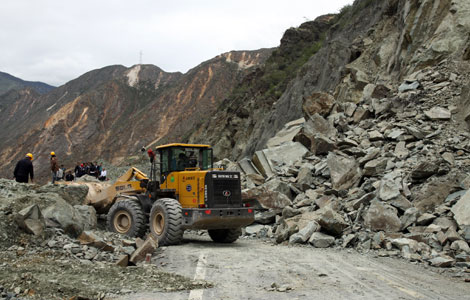Turkish tunnel gives China new route to Europe
Updated: 2013-11-01 23:10
By ZHAO LEI (China Daily)
|
||||||||
The opening of an underwater railway tunnel in Turkey can shorten travel times between Europe and Asia and boost rail freight between the two continents, rail experts say.
"With the Marmaray tunnel opening and serving rail networks in Europe and Asia, journey times between the two continents will be shortened substantially," said Yang Hao, a professor at Beijing Jiaotong University who researches rail transport management.
"Routes operating through the tunnel will be shorter than existing ones running through Russia to connect China and Western Europe, providing more options for freight carriers."
There are three rail lines that operate between China and Western Europe and two of them run through the vast areas of Siberia with the third crossing Kazakhstan before entering Russia, Yang said.
Using the tunnel, it will be possible for China to open a new route to Western Europe via Kyrgyzstan, Kazakhstan, Azerbaijan, Georgia and finally Turkey, he added.
The tunnel marks the realization of a plan initially proposed by an Ottoman sultan about 150 years ago.
It runs under the Bosporus, the strait that connects the Black Sea to the Sea of Marmara and splits Istanbul between Asia and Europe. The tunnel is 13.6 kilometers long, including an underwater stretch of 1.4 km.
It is among a number of infrastructure projects put forward by the Turkish government.
Started in 2004 and scheduled to be completed in four years, the tunnel's construction was delayed by important archeological finds, including a 4th century Byzantine port, as builders began digging under the city.
With the tunnel as a crucial section, the entire Marmaray Project is a 76-km railway development that will ferry travelers across the Bosporus and connect busy railway lines on either side of the historic waterway.
"We are connecting London to Beijing," Erdogan said of the project in October. "It is a dream of 150 years."
Ottoman Sultan Abdulmecid I is said to have proposed the idea of a tunnel under the Bosporus about a century and a half ago. One of his successors, Abdulhamid II, had architects submit proposals in 1891, but the plans were not carried out.
With the Marmaray tunnel and the Kars-Tbilisi-Baku railway project that will link Turkey, Azerbaijan and Georgia, an "Iron Silk Road" will be established, Suleyman Karaman, director of Turkish State Railways, said in an earlier report.
This will allow passenger and cargo traffic from Europe to reach destinations as far away as Central Asia and China more quickly via Turkey, Karaman said.
Zhao Jian, a professor who specializes in China's railway system, said: "In addition to freight transport, it is too early to predict when people will be able to travel from London to Beijing because a large proportion of this imaginary line is still missing."
The Associated Press contributed to this story.

 Halloween celebrations around the world
Halloween celebrations around the world
 Flooding sweeps Texas, killing 2
Flooding sweeps Texas, killing 2
 New road links remote Tibet county to rest of the country
New road links remote Tibet county to rest of the country
 Tan Dun premieres new work with Philadelphia Orchestra
Tan Dun premieres new work with Philadelphia Orchestra
 Two firms to debut in US at higher prices
Two firms to debut in US at higher prices
 Women fight to become China's next oceanauts
Women fight to become China's next oceanauts History under a new light
History under a new light
 Kung fu master becomes hit online
Kung fu master becomes hit online
Most Viewed
Editor's Picks

|

|

|

|

|

|
Today's Top News
'East Turkistan' behind Tian'anmen crash
German lawmaker meets Snowden in Moscow
White House defensive; health website flounders
Hainan Airlines reaches out across Canada
58.com's offering signals 'growing demand'
China securitization plan to include foreign banks
Firms heading home as benefits wane in China
China's PMI growth hits 18-month high
US Weekly

|

|






